Dive into The Rain Gauge: From Historical Evolution to Modern Applications
Dive into The Rain Gauge: From Historical Evolution to Modern Applications
Blog Article
DIY Rainfall Gauge: Straightforward Steps to Make Your Own
Creating your own DIY rain scale is a simple and effective method to gauge and videotape precipitation. With just a few typical products and some standard actions, you can quickly build your very own rainfall scale at home. Allow's obtain begun on making your DIY rainfall scale today!
Gather Products
To start creating your do it yourself rainfall scale, collect all the essential products making use of a thorough list of items. Having the right products on hand will certainly make sure the effective creation of your rain gauge and enable accurate measurements of rains. You will need a clear plastic container or cylinder, such as a plastic container or container. Make sure the container is transparent to make sure that you can conveniently see the water degree inside. Next, you will require a leader or gauging tape to note the increments on the container. This will allow you to gauge the amount of rainfall accurately. In addition, you will certainly require an irreversible pen or waterproof tape to mark the dimensions on the container. This will ensure that the markings continue to be noticeable even when revealed to rainfall. You will require a sturdy base or risk to safely hold your rainfall scale in place. This can be a wood or metal stake that can be put into the ground or a tough flat surface area to supply stability. Collecting these materials ahead of time will simplify the construction process and make sure that you have whatever you need to produce your very own DIY rainfall gauge.
Prepare the Container

Mark the Dimension Increments
To precisely gauge the quantity of rainfall, properly marking the measurement increments on your do it yourself rain gauge is necessary. Without clear and exact markings, it would be hard to figure out the exact quantity of rainfall collected in your rainfall have a peek at these guys gauge. Right here are the actions to mark the dimension increments on your rain gauge.
The most typical systems for measuring rainfall are inches and millimeters. As soon as you have selected the device, use a long-term pen or waterproof paint to mark the increments on the side of your rain gauge.
When noting the increments, it is very important to guarantee that they are equally visit their website spaced and plainly visible. Use a ruler or gauging tape to ensure accuracy and consistency. Furthermore, ensure that the markings are resistant to fading or abrading, as direct exposure to the components might create them to deteriorate gradually.
Area the Rainfall Scale Outdoors
The rainfall gauge must be placed outdoors to accurately collect rainfall data. The place selected for the rainfall scale must be open and cost-free from any obstructions that might possibly affect the measurement of rainfall. It is vital to discover an area that is not blocked by trees, buildings, or other structures that could block the rain from reaching the gauge. This will ensure that the collected data is rep of the real rains in the area.
In addition, it is important to position the rain scale on a secure surface area, such as a level ground or a sturdy blog post. This will certainly avoid any movement or tilting of the scale, which could lead to inaccurate dimensions. It is likewise recommended to avoid positioning the gauge near any kind of resources of artificial water, such as lawn sprinklers or drain systems, as this could hinder the precision of the measurements.
Display and Record Rain Data
Regular tracking and recording of rainfall information is necessary for precise information analysis and interpretation. By keeping an eye on rainfall dimensions, you can obtain beneficial insights right into weather condition patterns, environment patterns, and water source administration. To effectively keep an eye on and tape rainfall information, it is essential to establish a routine and keep consistent techniques.
Firstly, make sure that your rain gauge is placed in an open area far from obstacles such as trees or structures that might obstruct rainfall. In addition, see to it the rain scale is level and safely secured to avoid any type of activity that could impact the precision of the measurements.

When taping the rains data, it is very important to note the date and time of each measurement. Utilize a ruler or a determining stay with figure out the rains deepness in the rainfall scale, and record this info precisely.
To make certain the precision of the measurements, it is suggested to empty the rainfall scale after each recording. This will certainly avoid any overflow or evaporation from influencing succeeding dimensions.
Final Thought
In conclusion, developing a DIY rain scale is a practical and straightforward method to monitor and videotape rainfall information (The Rain Gauge). By complying with the steps detailed in this short article, you can easily collect materials, prepare the container, note the measurement increments, and put the rainfall gauge outdoors. Routinely monitoring and taping rainfall information can provide useful info for various objectives
Having the right products on hand will certainly make sure the effective creation of your rainfall scale and allow for exact measurements of rainfall.To properly measure the amount of rainfall, properly marking the measurement increments on your Do it yourself rainfall gauge is crucial.The rain gauge need to be placed outdoors to precisely accumulate rainfall data. The area chosen for the rain gauge must be open and free from any kind of blockages that could potentially impact the dimension of rainfall.In conclusion, producing a DIY rainfall scale is a simple and useful method to check and videotape rainfall data.
Report this page